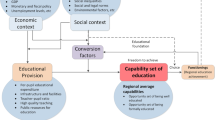Abstract
Some researchers in China believe that the rural poor’s earlier disadvantaged education experiences stopped them to get into the leading research universities. In my research, I find equal access to leading research universities relates with many issues, the gross enrollment rate disparity among provinces, the change of enrollment policies, the distributions of enrollment quotas, the urban/rural residence and disciplinary distribution all are the factors that put the rural poor in a difficult position to access the leading research universities. The paper concludes that in the race for creative minds, the leading research universities have forgotten their social responsibility of equity.
Similar content being viewed by others
References
Chen, C. (2009). Why the road for rural college students become so narrower? (In Chinese). http://edu.aweb.com.cn/2009/3/28/5118200.
Du L. (2010). Professor from Peking University: The inequality in student enrollment in Beijing and Shanghai (In Chinese). http://news.sina.com.cn/c/2010-01-06/041519406695.shtml.
Guizhou Daily. (2008). The gross enrollment in Guizhou has reached 11.5% in 2007 (In Chinese). http://www.gzu521.com/campus/article/examination/200804/167805.htm.
Hawkins, J. R., et al. (Ed.). (2008). Higher education in China: access, equity and equality in higher education in China. In D. B. Holsinger & W. J. James (Eds.), Inequality in education comparative and international perspectives (pp. 215–239). Berlin: Springer.
Huang, N. (2005). Do not confuse gross higher education enrollment with the scale of higher education (In Chinese). http://www.annian.net/show.aspx?id=11876&cid=25.
Jiang, G. (2007). The rural and urban difference in access to education opportunities (In Chinese). Unpublished Ph. D. dissertation, Nankai University.
Li, W. & Genandoy, H. (2004). Proceedings of the international conference on transforming the digital divide into digital opportunities for rural populations into conjunction with INRUED 10th Anniversary (p. 160). Baoding, China, 17–19 Oct 2004.
Liu, G. (2010). To see the tendency of Chinese higher education development from numbers (In Chinese). http://www.sciencenet.cn/m/user_content.aspx?id=350148.
Liu, J., et al. (2009). From the perspective of elite selection, identity, regions and capital—rural new entrants at Peking University 1978–2005 (In Chinese). Tsinghua Journal of Education, 30(5), 42–59.
Loyalka, P. K. (2009). Institutional mechanisms and sorting Across China’s higher education system (pp. 21–32). Unpublished conference paper, presented at the academic development conference of the Graduate School of Education, Peking University.
Luan, Z. (2007). Research and analysis of equal opportunity of higher education enrollment in Shandong Province (In Chinese). Unpublished master thesis, Shandong Normal University.
Ma, W. (2010a). Equity and access to tertiary education: Case study in China. World Bank Report.
Ma, W. (2010b). Chinese higher education: Current development and future prospects. Pubic lecture in May 24.
Min, W. (Ed.). (2009). Educational input, resource allocation and returns to human capital: Studies on the issues of Chinese education and human resources. Beijing: Economic Science Press. (In Chinese).
Qian, C., & Zhou, R. (2009). More attention should be given to the rural graduates in employment. Xinhua Comments (In Chinese). http://www.hq.xinhuanet.com.
The Association of Higher Education. (2009). Special report on academic activities of association of higher education in China, 6, 24.
The composition of students changed dramatically, it becomes more difficulty for rural students to get into the brand universities (In Chinese). http://edu.sina.com.cn/gaokao/2011-08-06/1118309006.shtml).
Xiang, L. (2010). Research on the fairness of college entrance recruiting system in China. Journal of Shijiazhuang Railway University, 4, 2. (In Chinese).
Xiao, J. (2007). A research on access and tuition in public universities. Unpublished master thesis, Wuhan University of Science and Technology (In Chinese).
Xiong, B. (2011). Where is the way out for rural students? http://www.china.org.cn/opinion/2011-08/11/content_23188351.htm.
Yang, D. (2006). Access to higher education: Widening social class disparities (In Chinese). Tsinghua Journal of Education, 27(1), 19–25.
Yao, Z. (2007). Research and Analysis on the issue of the equal opportunity of the higher education enrollment of Shandong Province (In Chinese).Unpublished master thesis. Shangdong Normal University.
Zhang, Y., et al. (2009). The gross enrollment of 16.17% Yunnan higher education has come to mass stage (In Chinese). http://gaokao.chsi.com.cn/gkxx/ss/200901/20090120/16757947.html.
Zhang, D., & Zhou, Y. (2002). Sociology of higher education. Beijing: Higher Education Press. (In Chinese).
Zhen, W. (2011). It is not hard for rural students get into colleges, but difficult to get into research universities (In Chinese). http://roll.soholcom/20110827/n317511243shtm.
Author information
Authors and Affiliations
Corresponding author
Rights and permissions
About this article
Cite this article
Ma, W. Why the rural poor get fewer opportunities to leading research universities?. Asia Pacific Educ. Rev. 13, 263–271 (2012). https://doi.org/10.1007/s12564-011-9201-x
Received:
Revised:
Accepted:
Published:
Issue Date:
DOI: https://doi.org/10.1007/s12564-011-9201-x




